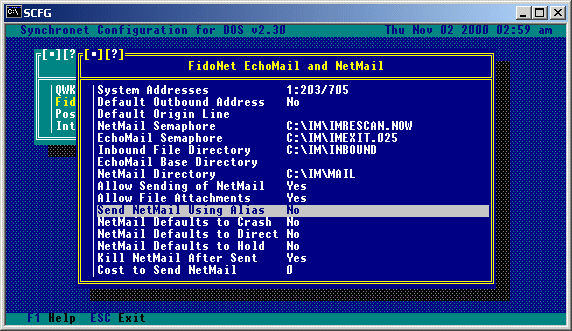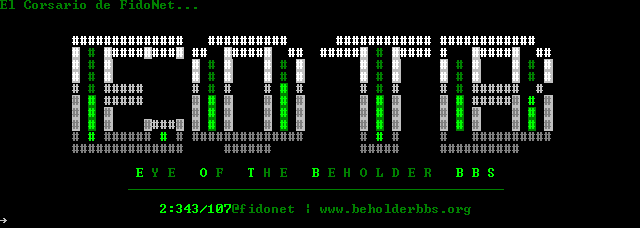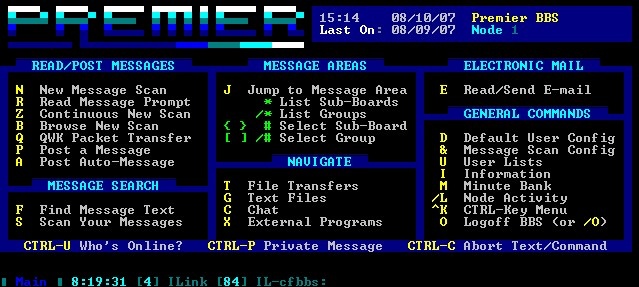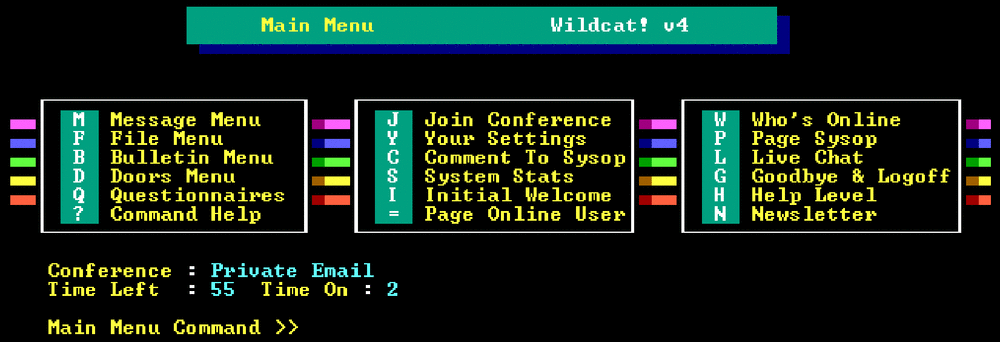BBS
A BBS was software (a set of computer programs installed on a computer) that was popular in the 1980s and 1990s in the United States on computer networks
It allowed participating users to connect through a telephone line to a network where they could see and consult different information published by other users
Currently, it is easily accessible through telnet (computer program to access an external server; not to be confused with the computer protocol of the same name) over the Internet to servers and perform functions such as downloading software, data, reading news and newsletters, exchange of messages with other users through email2, online gaming, etc.
They were the precursors of modern forums and other aspects of the Internet
Historically, the first BBS software is considered to have been created by Ward Christensen in 1978, while Usenet, for example, did not go live until the following year
During their years of popularity, BBSs were the meeting point for communications enthusiasts and software developers, and constituted the first public file sharing systems, including the first shareware programs and the first computer viruses
Unlike web pages on the Internet, by relying on a computer connected to a telephone line, users had to “wait in line”
That is, as long as the previous user did not disconnect and release the phone line, the next one could not connect (most BBS only had 1 phone line)
With the rise of the Internet in the second half of the 90s, BBS decreased in popularity, although that does not mean they have disappeared: today they continue to exist and have adapted to the Internet, using it to facilitate access to the BBS

It is worth highlighting the systems linked by the FidoNet network that, altruistically maintained by their Sysops (system operators or system administrators), use software compatible with each other that allows them to act as a server for the BBS system and exchange mail packets with other nodes. which, moving from node to node, were distributed throughout the world
FidoNet constitutes a quality alternative for email, unrelated to the spam that prevails in forums, news and mailing lists
Many boards continued to operate until 2014

In Spain there were pucela_bbs (located in Valladolid), Eye Of The Beholder (by Enric Lleal, in Barcelona) and VampireBBS (by Belky, in Barcelona)
For its part, there were in other countries of the world, such as Argentina, where Mummy BBS, Rolling BBS (maintaining the traditional Dial-Up connection) and Matrix BBS still operate via telnet
Even platform users Amiga they had a large number of BBSs, some of the best known being: Amiga Penedès, Hypnosys BBS, Euskal Amiga BBS, Nyarlothotep BBS, oDRuSBa BBS, etc.
History
The first BBS was CBBS (Computerized Bulletin Board System), created by Ward Christensen
It was put online on February 16, 1978 in Chicago
The first BBS ran on large systems (usually in universities), PCs or home computers such as Apple II, the TRS-80, the Atari 800 or the Commodore 64, with 300 baud modems, which made the transfer extremely slow (a 64 KB program could take up to 30 minutes to transmit)
The advent of 1200 and 2400 baud modems increased their popularity and they began to grow
But the storage problem was still present, as they were usually computers with a floppy drive with an average capacity of 180 KB (only a privileged few could afford up to 4 floppy disks), which forced the sysop to make manual changes
The advent of hard drives for both systems was embraced by all those who could afford it
The appearance of 16 bit computers led to a migration to the platforms of each manufacturer until the fall in prices of the PC clones (and especially their notably cheaper hard drive, as well as their internal modems) led to the generalization of their use in BBS
However, they survived until 2014 some running on Commodore Amiga, Mac, Commodore 64 or TRS-80 IV
As multitasking operating systems such as Amiga OS, OS/2, Unix (in its many variants) became available, Windows 95 or added to MS-DOS as DESQview or Windows 3.1, increased the number of BBS
Those who had restricted hours were able to operate 24 hours a day by being able to use Sysops on their own computer instead of needing a dedicated one
This coincided with the advent of 14,400 baud modems, which marked a major leap in communications speed
Along with the emergence of peer networks such as Fidonet, WWIVnet or VirtualNET, many computer companies began to maintain their own BBSs to support their products (support forums, patches, drivers, shareware versions of Antivirus or compilers, etc.) while maintaining a presence on CompuServe (a kind of global paid BBS with local access points in certain countries)
In a few cases, they opted to financially maintain a BBS in Fido, which is very specialized in their products as official support
In Spain, some of Fido's most important BBSs began to offer paid access at high speeds (in addition to 1 or 2 free public access modems, they had 1 to 10 additional lines with the fastest and most expensive modems of the moment) and even access to the incipient Internet
Some of them helped found IRC-Hispano, an IRC-based social network in Spanish
The programs of the BBS used to be written either in assembler for each machine, or in Pascal (Turbo Pascal above all) or C
The latter made it easy to port to different hardware platforms
A particular case was Virtual BBS, not only because it was written in Quick BASIC (without this implying a decrease in speed), but also because its author, Roland De Graaf, was blind
There were two main ways to use the BBS:
- Online Connection: It resulted in phone bills and locking up the system for other users to do so
- Offline Connection: In each connection, the new e-mails and posts in the forums were uploaded, the files that were contributed to the exchange area, and after that, the new messages and the selected files were downloaded
Offline connection made it possible to shorten the connection time
Packages could be monolithic composed of several interchangeable programs, and specialized in a specific or general purpose BBS
The most popular were Fidonet's dot package and BlueWave (a multiBBS client)
Packages generalized the custom of including at the bottom of each message a famous quote or phrase, which may or may not be related to the subject of the message (there are compilations of about 100,000 quotes)
More modern clients (such as BlueWave) allowed not only to assign blocks of appointments to certain areas, but also to customize the tags depending on who was being answered or the topic being discussed
With the generalization of the Internet and its graphical interface (in contrast to the text interface of the BBS), graphic clients began to emerge that allowed a more visual connection, with the use of additional codes to include icons or images, but they did not reach much popularity
Presentation
A BBS was usually text based, rather than a GUI, and early conversation BBSs used the ASCII character set
However, some computer manufacturers extended the ASCII character set to take advantage of the advanced color and graphics capabilities of their systems

The authors of the BBS software included these extended character sets in their software, and the authors of the terminal program included the ability to display them when a compatible system was called
The native character set of Atari it was known as ATASCII, while most of the BBS wildcards supported PETSCII
PETSCII was also supported by the nationwide online service Quantum Link
The use of these custom character sets was generally incompatible between manufacturers
Unless a user was using a terminal emulation program written for the same type of system as the BBS and running on it, the session would simply revert to a simple ASCII output
For example, a user of Commodore 64 calling a BBS Atari it would use ASCII instead of the machine's native character set
As time went on, most terminal programs began to use the ANSI standard, but they could use their native character set if it were available
COCONET, a BBS system created by Coconut Computing Inc., was released in 1988 and only supported one GUI (initially no text interface was available but was finally available in 1990), and worked in EGA/VGA graphics mode, which made it overhanging in text based BBS systems
COCONET's bitmaps and vector graphics and support for multi-type fonts were inspired by the PLATO system, and the graphics capabilities were based on what was available in the Borland BGI graphics library
A competitive approach called the Remote Imaging Protocol (RIP) emerged and was promoted by Telegrafix in the early to mid-1990s, but it never became widespread
It was also considered an industry-standard technology called NAPLPS, and although it became the underlying graphics technology behind the Prodigy service (online service), it never gained popularity in the BBS market
There were several GUI-based BBSs on the Apple Macintosh platform, including TeleFinder and FirstClass, but these remained widely used only in the Mac market
In the UK, BBC Micro based OBBS software, available from Pace for use with its modems, optionally for colour and graphics using the Teletext based graphics mode available on that platform
Other systems used the Viewdata protocols popularized in the U.K. by the British Telecom service Prestel, and the online magazine Micronet 800 which were busy giving away modems with their subscriptions
The most popular form of inline graphics was ANSI art, which combined the blocks and symbols of the IBM Extended ASCII character set with ANSI escape sequence to allow on-demand color change, provide cursor control and screen formatting, and even basic musical tones
In the late 1980s and early 1990s, most BBSs used ANSI to create elaborate splash screens and colored menus, and thus ANSI support was a highly requested feature in terminal client programs
The development of art at ANSI became so popular that it spawned an entire BBS "artscene" and a subculture dedicated to it
Skyline BBS for Amiga, written by Scott Lee, was the first in 1987 with a script markup language communication protocol called Skypix that was capable of providing the user with a complete graphical interface, with rich graphical content, changeable fonts, controlled actions. the mouse, animations and sound

Today, most of the BBS software that is still active, such as Worldgroup, Wildcat! BBS and Citadel/UX, is Web-enabled and the traditional text interface has been replaced (or operates concurrently) with a Web-based user interface
For those more nostalgic for the true BBS experience, one can use NetSerial (Windows) or DOSBox (Windows/*nix) to redirect the software from DOS COM port to telnet
This allowed them to connect to BBS via telnet as in the 1980s and 1990s using software that emulated a modem terminal, such as Telix, Terminate, Qmodem and Procomm Plus
The most modern 64 bit terminal emulators such as PuTTY and SyncTerm include native telnet support and even SSH connection encryption
